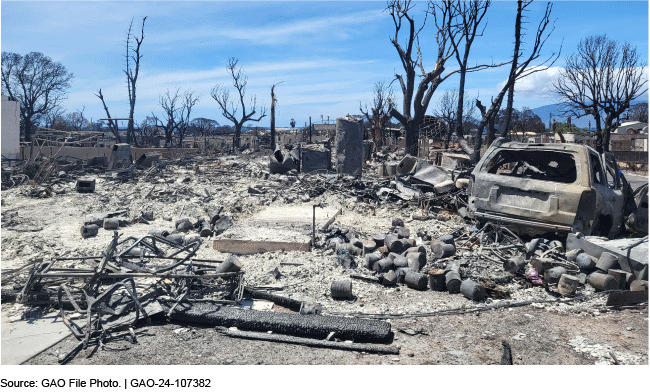Wildfire Disasters: Opportunities to Improve Federal Response, Recovery, and Mitigation Efforts
Fast Facts
Wildfires are growing in size and severity, and the nation is experiencing longer wildfire seasons. In August 2023, the deadliest U.S. wildfire in over a century was on the island of Maui in Hawaii. Numerous federal departments and agencies have roles in wildfire preparedness, response, and recovery. Demand for related federal programs and resources is expected to increase.
We testified on:
Our ongoing work looking at FEMA's assistance to survivors and communities affected by wildfires
Barriers to recruitment and retention of wildland firefighters
Challenges with interagency coordination
Residential Wildfire Debris, Lahaina, Hawaii, September 2023

Highlights
What GAO Found
GAO's ongoing and prior work identified challenges that federal agencies face:
- Wildfire response and recovery. GAO has previously reported that the Federal Emergency Management Agency (FEMA) faces challenges in assisting state, local, and tribal governments after wildfire events. For example, securing temporary housing for survivors is difficult because disasters exacerbate pre-disaster shortages of affordable housing. Further, wildfires generally destroy entire structures and leave contaminated debris and soil that require lengthy clean-up before property is safe for habitation. FEMA is taking steps to address these post-disaster housing challenges and GAO will continue to assess these efforts in its ongoing work.
Residential Wildfire Debris, Lahaina, Hawaii, September 2023

- Recruitment and retention of wildland firefighters. GAO's prior work identified barriers to the recruitment and retention of federal wildland firefighters, including low pay and opportunities for career advancement. Congress has authorized pay increases through fiscal year 2026, but longer-term solutions are needed, according to agency officials.
- Interagency coordination. GAO's prior work identified opportunities for improved interagency coordination in managing risks from wildfire smoke and in federal disaster recovery efforts. In March 2023, GAO made recommendations to help strengthen federal coordination between the Environmental Protection Agency and land management agencies in reducing risks to air quality and public health from wildfire smoke. As of March 2024, four of the six recommendations were partially addressed. Additionally, in November 2022, GAO reported that the federal approach to disaster recovery is fragmented across more than 30 federal agencies and departments and at least 32 congressional committees. GAO recommended that agencies identify and take steps to better manage this fragmentation and that Congress consider establishing an independent commission to recommend reforms to the federal government's approach to disaster recovery. As of March 2024, a commission has not been established.
Why GAO Did This Study
In recent decades, the nation has witnessed an increase in the size and severity of wildfires as well as longer wildfire seasons. Demand for federal resources to prepare for, respond to, or recover from these wildfires is expected to increase.
This testimony discusses GAO's ongoing and prior work and recommendations on challenges related to (1) wildfire response and recovery, (2) recruitment and retention of wildland firefighters, and (3) interagency coordination.
This statement is based on GAO's ongoing work on FEMA's wildfire prevention and recovery efforts and prior reports, published from November 2022 through March 2023. For its ongoing work, GAO reviewed relevant FEMA policies, procedures, and guidance related to wildfires; conducted a site visit to Hawaii to observe response and recovery efforts; and interviewed relevant FEMA officials. Details about the scope and methodology for published GAO reports are included in those products.
Recommendations
GAO made 10 recommendations in the reports covered by this statement, including ones aimed at improving agency coordination and addressing fragmentation in federal wildfire efforts. As of March 2024, five of these recommendations have been partially addressed, but all 10 remain open.
